Repurposing Dredged Canal Sediment for Topsoil at Bowling, Scotland
Abstract
1. Introduction
2. Materials and Methods
3. Results
4. Discussion
4.1. When Should Phyto-Remediation Be Considered for Dredged Sediment?
4.2. Impact of Contaminants
4.3. Future Work
5. Conclusions
Author Contributions
Funding
Institutional Review Board Statement
Informed Consent Statement
Data Availability Statement
Acknowledgments
Conflicts of Interest
References
- European Union. Directive 2008/98/EC of the European Parliament and the Council of 19 November 2008 on Waste and Repealing Certain Directives. In Official Journal of the European Union; European Union: Maastricht, The Netherlands, 2008. [Google Scholar]
- Lassière, O.L.; Smith, N.A.; Johnstone, J.B.G.; Hamilton, A.R.; Gálvez, R.; Dyer, M.; Dean, S.W. A new approach to sustainable canal sediment management in Scotland. J. ASTM Int. 2009, 6, 102184-JAI102184. [Google Scholar] [CrossRef]
- Ferrans, L.; Nilsson, A.; Schmieder, F.; Pal, D.; Rahmati-Abkenar, M.; Marques, M.; Hogland, W. Life Cycle Assessment of Management Scenarios for Dredged Sediments: Environmental Impacts Caused during Landfilling and Soil Conditioning. Sustainability 2022, 14, 13139. [Google Scholar] [CrossRef]
- Hadj Sadok, R.; Maherzi, W.; Benzerzour, M.; Lord, R.; Torrance, K.; Zambon, A.; Abriak, N.-E. Mechanical Properties and Microstructure of Low Carbon Binders Manufactured from Calcined Canal Sediments and Ground Granulated Blast Furnace Slag (GGBS). Sustainability 2021, 13, 9057. [Google Scholar] [CrossRef]
- Renella, G. Recycling and Reuse of Sediments in Agriculture: Where Is the Problem? Sustainability 2021, 13, 1648. [Google Scholar] [CrossRef]
- Möller, A.; Ahrens, L.; Surm, R.; Westerveld, J.; van der Wielen, F.; Ebinghaus, R.; de Voogt, P. Distribution and sources of polyfluoroalkyl substances (PFAS) in the River Rhine watershed. Environ. Pollut. 2010, 158, 3243–3250. [Google Scholar] [CrossRef] [PubMed]
- Garcés-Ordóñez, O.; Saldarriaga-Vélez, J.F.; Espinosa-Díaz, L.F.; Canals, M.; Sánchez-Vidal, A.; Thiel, M. A systematic review on microplastic pollution in water, sediments, and organisms from 50 coastal lagoons across the globe. Environ. Pollut. 2022, 315, 120366. [Google Scholar] [CrossRef] [PubMed]
- Cortis, R. A Study of Potentially Toxic Elements in the Forth and Clyde Canal, Scotland, UK. In Department of Pure and Applied Chemistry; University of Strathclyde: Glasgow, UK, 2013; p. 292. [Google Scholar]
- Cavoura, O.; Brombach, C.; Cortis, R.; Davidson, C.; Gajdosechova, Z.; Keenan, H.; Krupp, E. Mercury alkylation in freshwater sediments from Scottish canals. Chemosphere 2017, 183, 27–35. [Google Scholar] [CrossRef] [PubMed]
- Bangkedphol, S.; Keenan, H.; Davidson, C.; Sakultantimetha, A.; Songsasen, A. The partition behavior of tributyltin and prediction of environmental fate, persistence and toxicity in aquatic environments. Chemosphere 2009, 77, 1326–1332. [Google Scholar] [CrossRef] [PubMed]
- Barciela-Rial, M.; Saaltink, R.M.; van Kessel, T.; Chassagne, C.; Dekker, S.C.; de Boer, H.J.; Griffioen, J.; Wassen, M.J.; Winterwerp, J.C. A new setup to study the influence of plant growth on the consolidation of dredged cohesive sediment. Front. Earth Sci. 2023, 11, 169. [Google Scholar] [CrossRef]
- Smith, K.E.; Banks, M.K.; Schwab, A.P. Dewatering of contaminated sediments: Greenhouse and field studies. Ecol. Eng. 2009, 35, 1523–1528. [Google Scholar] [CrossRef]
- Dowds, T.J. The Forth and Clyde Canal. A History; Tuckwell Press: East Linton, UK, 2001; p. 104. [Google Scholar]
- Fleming, G. The Millennium Link. The rehabilitation of the Forth & Clyde and Union Canals. In Proceedings of the International Conference Organized by the Institute of Civil Engineers, Edinburgh, UK, 30 June–1 July 2000; Thomas Telford: Edinburgh, UK, 2000. [Google Scholar]
- Glasgow’s Canal Regeneration Partnership. Canal Action Plan 2015–2020. 2015. Available online: https://www.glasgow.gov.uk/index.aspx?articleid=29101 (accessed on 7 April 2023).
- Tieges, Z.; McGregor, D.; Georgiou, M.; Smith, N.; Saunders, J.; Millar, R.; Morison, G.; Chastin, S. The Impact of Regeneration and Climate Adaptations of Urban Green–Blue Assets on All-Cause Mortality: A 17-Year Longitudinal Study. Int. J. Environ. Res. Public Health 2020, 17, 4577. [Google Scholar] [CrossRef] [PubMed]
- Climate Change (Emissions Reduction Targets) (Scotland) Act 2019. In 2019 asp; Arup: London, UK, 2019.
- Noble, S. The Vanished Railways of Old Western Dunbartonshire; The History Press: Stroud, UK, 2010. [Google Scholar]
- Ove Arup & Partners Scotland. Bowling Basin Development. Geotechnical & Contamination Report. For Morrison Homes Ltd. Job Number 46861-01; Arup: London, UK, 1999. [Google Scholar]
- Riddell, J.F. Clyde Navigation. A History of the Development and Deepening of the River Clyde; John Donald Publishers: Edinburgh, UK, 1979. [Google Scholar]
- Arup. Draft Bowling Basin Flood and Erosion. Scoping Report REP/001/MP; Arup: London, UK, 2012. [Google Scholar]
- Lemière, B.; Laperche, V.; Wijdeveld, A.; Wensveen, M.; Lord, R.; Hamilton, A.; Haouche, L.; Henry, M.; Harrington, J.; Batel, B.; et al. On-Site Analyses as a Decision Support Tool for Dredging and Sustainable Sediment Management. Land 2022, 11, 274. [Google Scholar] [CrossRef]
- Lord, R.A. Reed canarygrass (Phalaris arundinacea) outperforms Miscanthus or willow on marginal soils, brownfield and non-agricultural sites for local, sustainable energy crop production. Biomass Bioenergy 2015, 78, 110–125. [Google Scholar] [CrossRef]
- BS 3882:2015; BS 3882:2015 Specification for Topsoil. British Standards Institute: London, UK, 2015.
- Nathanail, P.; McCaffrey, C.; Gillett, A.; Ogden, R.; Nathanail, J. The LQM/CIEH S4ULs for Human Health Risk Assessment; Land Quality Press: Nottingham, UK, 2015. [Google Scholar]
- Central Dredging Association. Beneficial Use of Sediments. Case Studies. Available online: https://www.dredging.org/resources/ceda-publications-online/beneficial-use-of-sediments-case-studies (accessed on 23 March 2023).
- Buyang, S.; Yi, Q.; Cui, H.; Wan, K.; Zhang, S. Distribution and adsorption of metals on different particle size fractions of sediments in a hydrodynamically disturbed canal. Sci. Total Environ. 2019, 670, 654–661. [Google Scholar] [CrossRef]
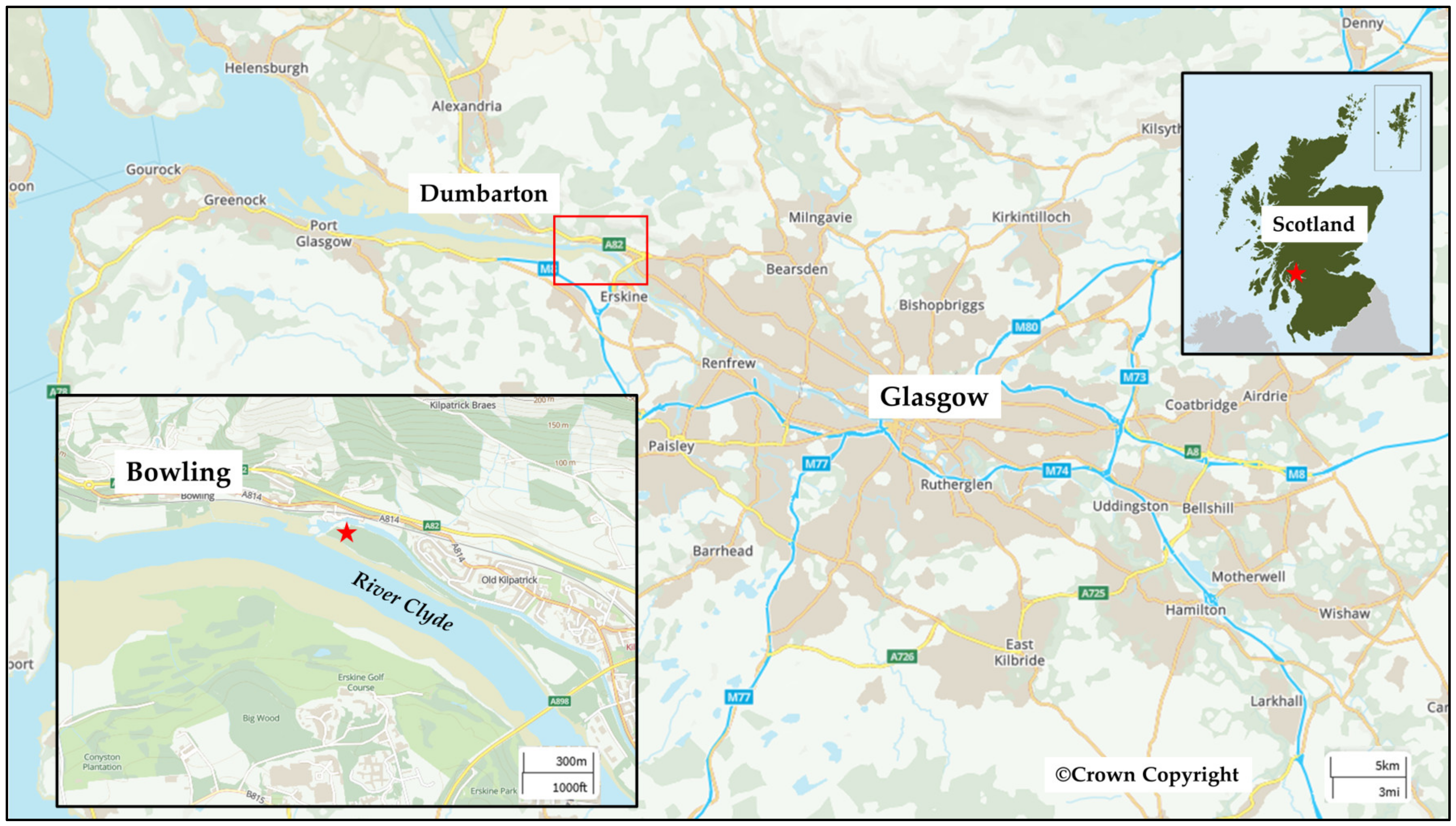
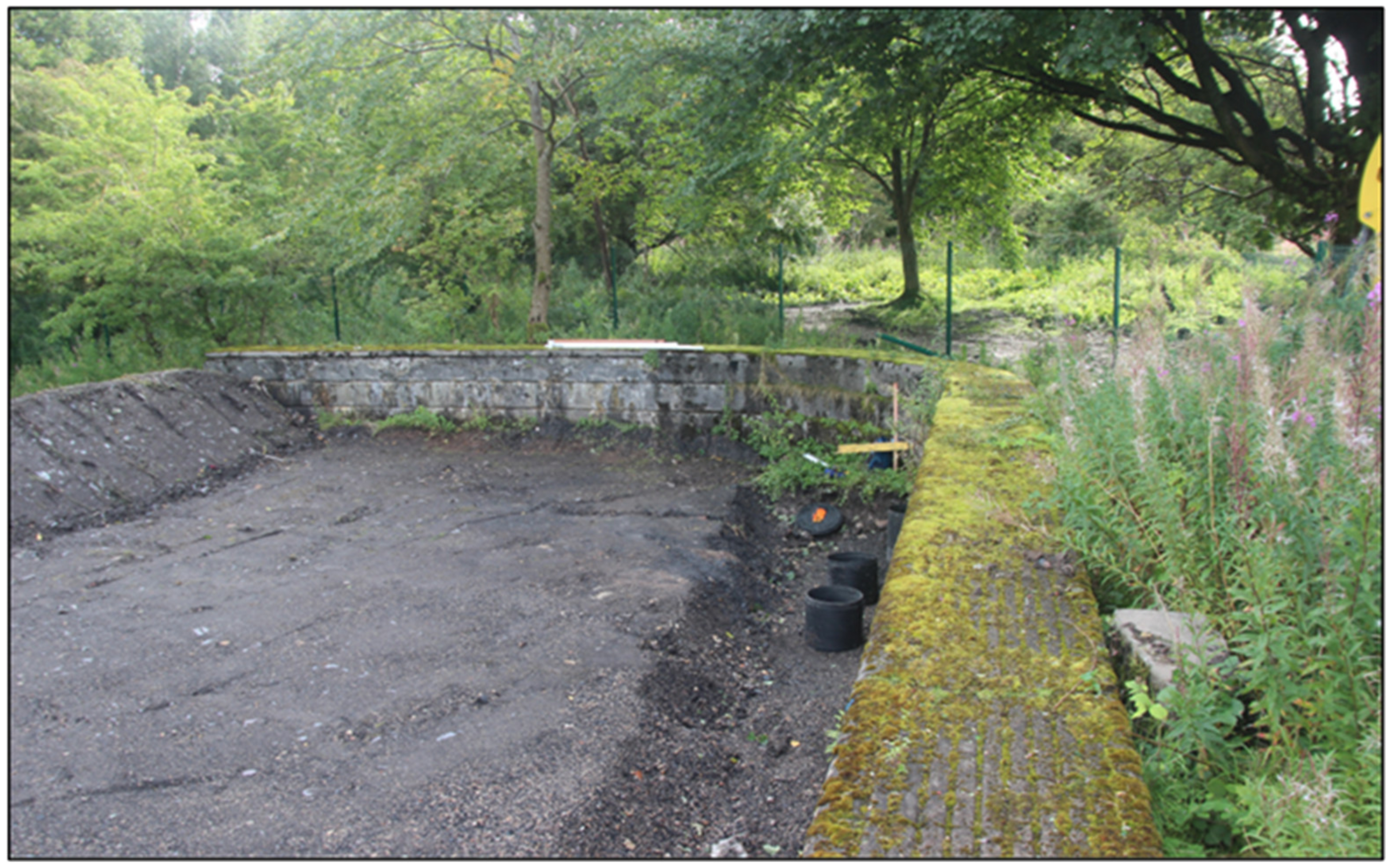
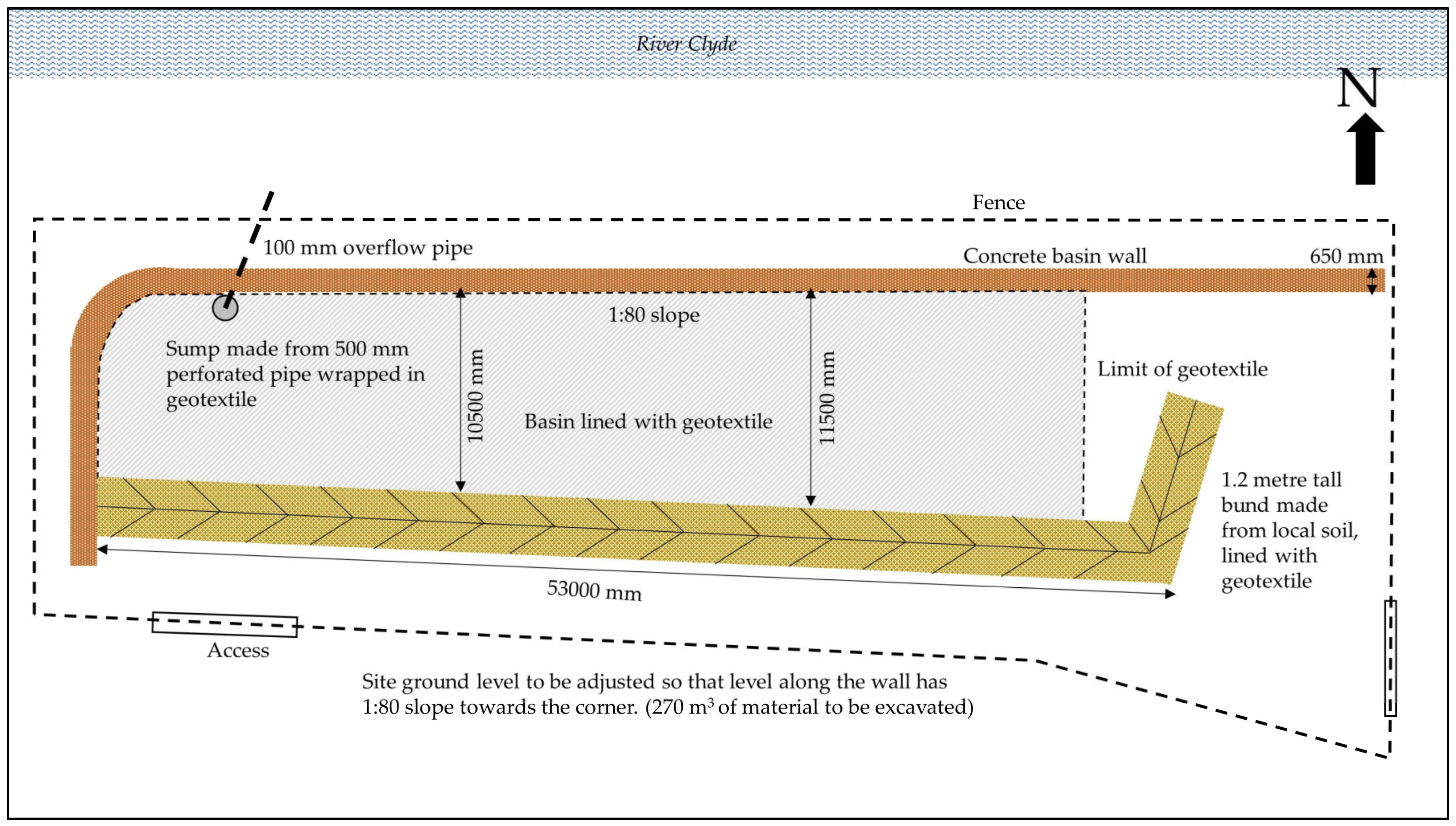
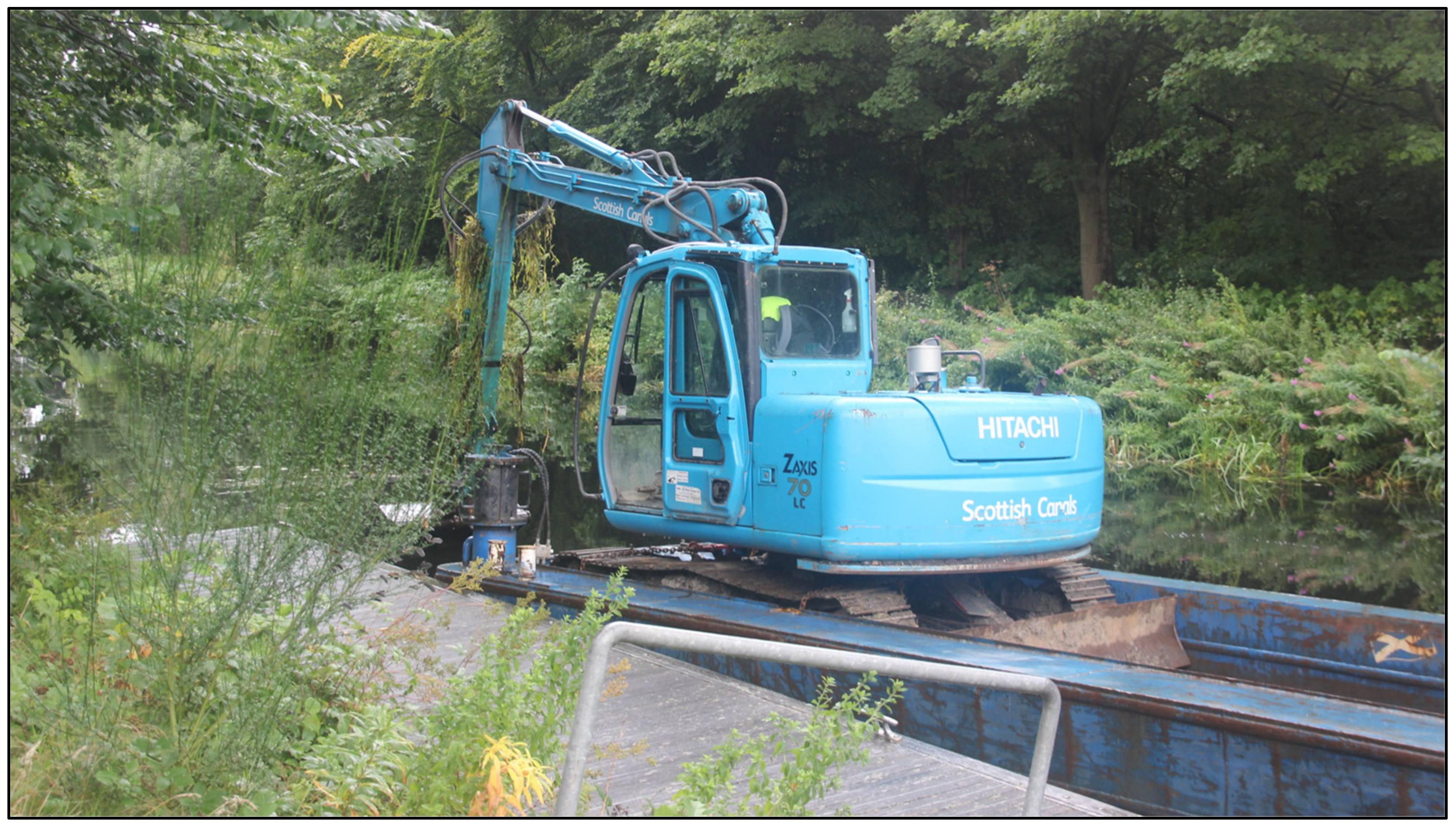

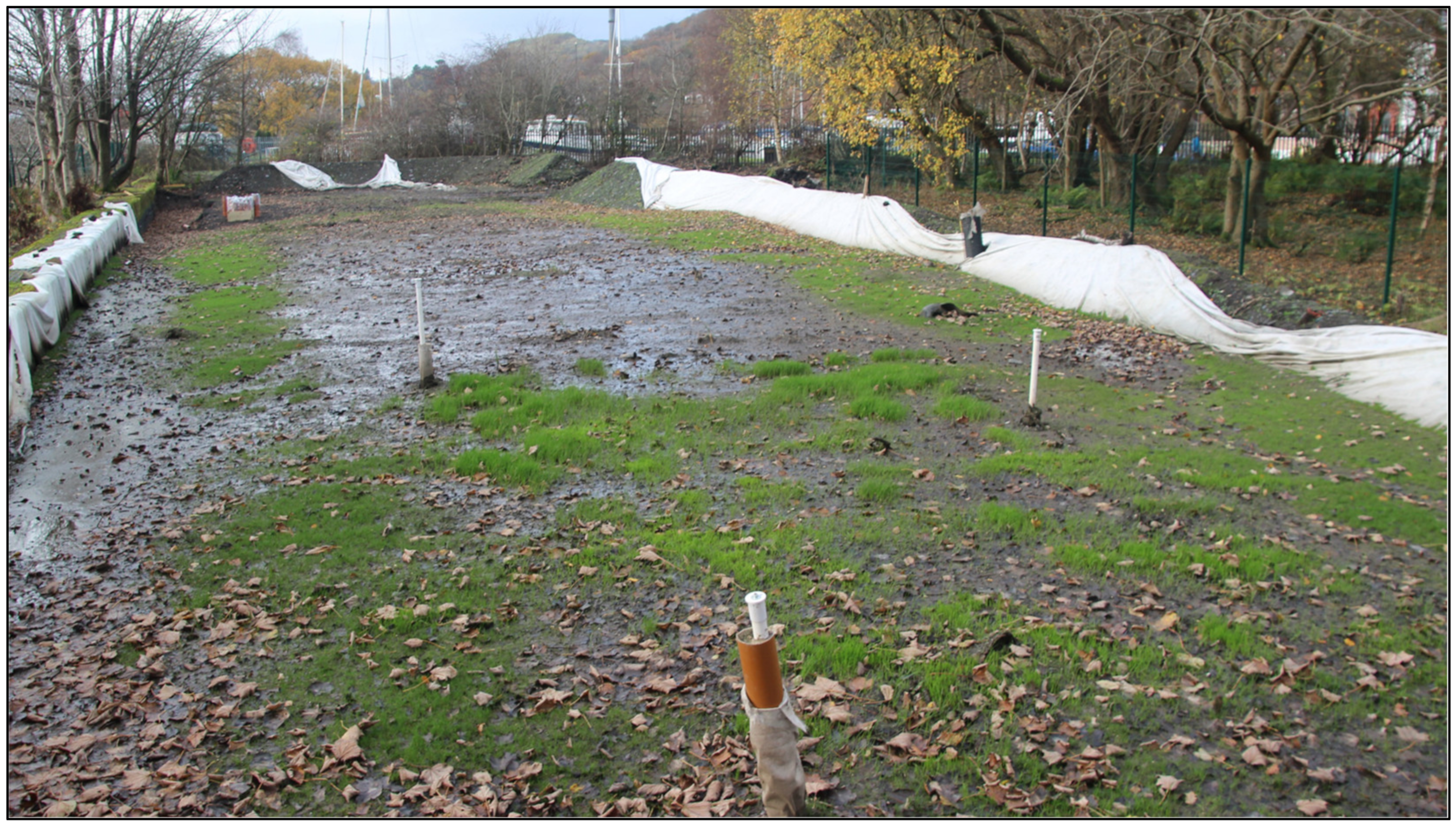

| Sample ID | SC/090/001 | SC/090/002 | SC/090/003 | SC/090/004 | SC/090/005 |
|---|---|---|---|---|---|
| Grid Ref | NS465 9672578 | NS468 5172065 | NS472 7971812 | NS476 0771480 | NS48034 71283 |
| pH | 6.99 | 7.17 | 7.39 | 7.30 | 7.34 |
| Loss on ignition (550 °C) w/w | 20.7% | 26.7% | 23.8% | 18.7% | 16.0% |
| Dry matter at 40 °C w/w | 20.1% | 15.5% | 14.2% | 19.0% | 24.5% |
| As (mg/kg) | 72 | 33 | 32 | 39 | 36 |
| Ba (mg/kg) | 315 | 281 | 274 | 274 | 302 |
| Cd (mg/kg) | 3.1 | 3.1 | 2.9 | 2.5 | 2.6 |
| Cu (mg/kg) | 236 | 157 | 170 | 172 | 161 |
| Total Cr (mg/kg) | 100 | 75 | 67 | 61 | 79 |
| Cr (VI) mg/kg) | <1 | <1 | <1 | <1 | <1 |
| Cr (III) (mg/kg) | 100 | 75 | 67 | 61 | 79 |
| Pb (mg/kg) | 301 | 186 | 193 | 193 | 216 |
| Hg (mg/kg) | 0.76 | 1.19 | 2.32 | 2.57 | 2.71 |
| Ni (mg/kg) | 61 | 50 | 43 | 39 | 49 |
| Se (mg/kg) | 3 | 3 | 3 | 4 | 3 |
| Zn (mg/kg) | 1460 | 1180 | 1310 | 1040 | 1090 |
| GG6 Banks Seed Mix | Italian Rye Grass | Westerwolds Rye Grass | |
|---|---|---|---|
| Seed mixture | Chewings Fescue 25% Strong Creeping Red Fescue 60% Flattened Meadow Grass 10% Browntop Bent 5% | Italian Rye Grass 100% | Westerwolds Rye Grass 100% |
| Application | 35 g per m2 | 35 g per m2 | 35 g per m2 |
| 6-9-6 fertilizer | 40 g per m2 | 40 g per m2 | 40 g per m2 |
| Germination | Within 3 weeks | Within 3 weeks | Within 3 weeks |
| Plot | Mix | Application |
|---|---|---|
| 1A | GG6 Banks seed mix | 20 g per m2 |
| 2A | Annual (Italian) rye grass | 20 g per m2 |
| 3A | Annual (Westerwolds) rye grass | 20 g per m2 |
| 4A | Reed canarygrass | 20 g per m2 |
| 5A | Perennial rye grass | 20 g per m2 |
| 6A | Wildflower mix Pro Flora 8 | 20 g per m2 |
| 7A | Control plot | 20 g per m2 |
| 18 January 2021 | ||||
|---|---|---|---|---|
| Monitoring location | ||||
| Depth bgl * | MP1 | MP2 | MP3 | MP4 |
| 10 cm | 41.6% | 43.2% | 41.4% | 43.0% |
| 20 cm | 47.2% | 48.6% | 39.3% | 31.7% |
| 30 cm | 51.7% | 49.9% | 47.4% | 50.7% |
| 40 cm | 53.5% | 55.2% | 45.3% | 54.4% |
| 10 March 2021 | ||||
| Depth bgl | MP1 | MP2 | MP3 | MP4 |
| 10 cm | 42.6% | 43.9% | 41.3% | 47.3% |
| 20 cm | 46.8% | 48.0% | 39.2% | 30.4% |
| 30 cm | 52.3% | 49.6% | 47.4% | 49.3% |
| 40 cm | 54.2% | 54.9% | 44.2% | 53.9% |
| Characteristic | BS 3882:2015 Acceptable Range or Limits | Conditioned Sediment | In Situ Canal Sediment |
|---|---|---|---|
| Sample Ref | N/A | 45032–507869 | 20/07344 |
| Moisture | Not specified | 21% | 81.3% |
| Texture | >2 mm <30% >20 mm <10% >50 mm 0 | Clay loam >2 mm 2.4 >20 mm 0 >50 mm 0 | N/A |
| Mass loss on ignition | 3 to 20% | 6.1% (@430 °C) | 21.2 (@550 °C) |
| Soil pH | 5.5–8.5 | 8.3 | 7.2 |
| Conductivity | 3300 µS cm−1 | 2038 µS cm−1 | N/A |
| Total nitrogen (%) m/m | >0.15 | 0.19 | |
| Extractable PO4 mg/L | 16 to 140 | 11.8 | |
| Extractable K mg/L | 121 to 1500 | 109 | |
| Extractable Mg mg/L | 51–600 | 193 | |
| C: N ratio | <20:1 | 17.8:1 | |
| Zn mg kg−1 | <200 | 559 | 1216 |
| Cu mg kg−1 | <100 | 79.8 | 152 |
| Ni mg kg−1 | <60 | 39.6 | 48 |
Disclaimer/Publisher’s Note: The statements, opinions and data contained in all publications are solely those of the individual author(s) and contributor(s) and not of MDPI and/or the editor(s). MDPI and/or the editor(s) disclaim responsibility for any injury to people or property resulting from any ideas, methods, instructions or products referred to in the content. |
© 2023 by the authors. Licensee MDPI, Basel, Switzerland. This article is an open access article distributed under the terms and conditions of the Creative Commons Attribution (CC BY) license (https://creativecommons.org/licenses/by/4.0/).
Share and Cite
Torrance, K.; Lord, R.A.; Hamilton, A.; Berry, P. Repurposing Dredged Canal Sediment for Topsoil at Bowling, Scotland. Sustainability 2023, 15, 9261. https://doi.org/10.3390/su15129261
Torrance K, Lord RA, Hamilton A, Berry P. Repurposing Dredged Canal Sediment for Topsoil at Bowling, Scotland. Sustainability. 2023; 15(12):9261. https://doi.org/10.3390/su15129261
Chicago/Turabian StyleTorrance, Keith, Richard Alastair Lord, Alasdair Hamilton, and Paul Berry. 2023. "Repurposing Dredged Canal Sediment for Topsoil at Bowling, Scotland" Sustainability 15, no. 12: 9261. https://doi.org/10.3390/su15129261
APA StyleTorrance, K., Lord, R. A., Hamilton, A., & Berry, P. (2023). Repurposing Dredged Canal Sediment for Topsoil at Bowling, Scotland. Sustainability, 15(12), 9261. https://doi.org/10.3390/su15129261







